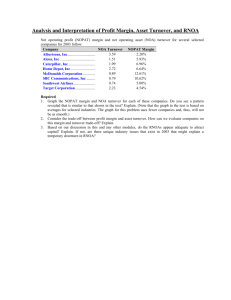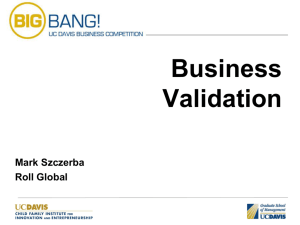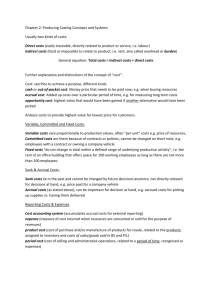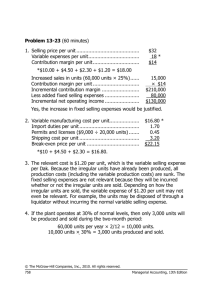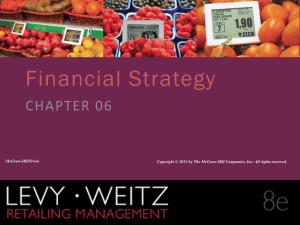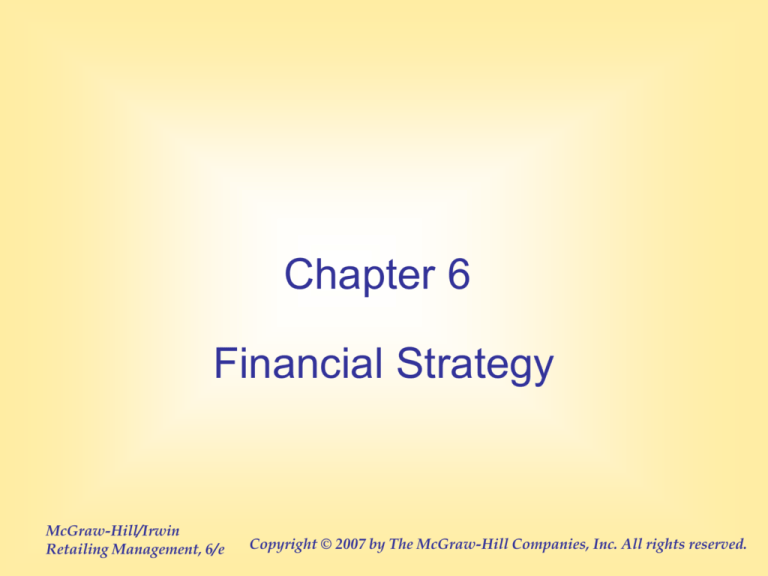
Chapter 6
Financial Strategy
McGraw-Hill/Irwin
Retailing Management, 6/e
Copyright © 2007 by The McGraw-Hill Companies, Inc. All rights reserved.
This chapter examines:
1) how the financial analysis can be used to
assess the retailer's performance,
2) assess the reasons its performance is above
or below expectations and
3) provide insights into appropriate actions that
can be taken if performance falls short.
McGraw-Hill/Irwin
Retailing Management, 6/e
Copyright © 2007 by The McGraw-Hill Companies, Inc. All rights reserved.
Objectives and Goals
First step in the strategic planning process involves
articulating the retailer’s objectives and the scope of
activities it plans to undertake.
These objectives guide the development of the retailer’s
Strategy.
Three types of objectives retailer might have are:
1) Financial objectives
2) Societal objectives
3) Personal Objectives
McGraw-Hill/Irwin
Retailing Management, 6/e
Copyright © 2007 by The McGraw-Hill Companies, Inc. All rights reserved.
Financial Objectives
Most people focus on profit to assess the financial
performance and this is not RIGHT!!!
It is not profits it is RETURN ON INVESTMENT (ROI)
Aiming for profit
Amount of money
Invested
ROI
Performance
$100,000
$500,000
20%
Excellent
$100,000
$2,000,000
5%
Poor
A common used measure of ROI is RETURN On ASSESTS (ROA)
McGraw-Hill/Irwin
Retailing Management, 6/e
Copyright © 2007 by The McGraw-Hill Companies, Inc. All rights reserved.
Societal Objectives
Societal objectives are related to broader issues about
providing benefits to society-Making the world better
place to live.
Examples: retailers might be concerned about
providing employment opportunities etc.
Performance with respective to societal objectives is
more difficult to measure than financial objectives.
We rely on percentages for example percentage of women
Employed in the retailer Business.
McGraw-Hill/Irwin
Retailing Management, 6/e
Copyright © 2007 by The McGraw-Hill Companies, Inc. All rights reserved.
Personal Objectives
Many retailers especially owners of small business have
personal objectives such as self-gratification, status, and
respect
Examples: retailers might be concerned about
providing employment opportunities etc.
Performance with respective to societal objectives is
more difficult to measure than financial objectives.
We rely on percentages for example percentage of women
Employed in the retailer Business.
McGraw-Hill/Irwin
Retailing Management, 6/e
Copyright © 2007 by The McGraw-Hill Companies, Inc. All rights reserved.
Strategic Profit Model
The strategic profit model is a method for summarizing the
Factors that affect a firm’s financial performance by ROA.
The model decomposes ROA into two components:
1) Net profit margin and
2) Asset turnover
The net profit margin is simply how much profit (after tax) a firm
Makes divided by its net sales.
It reflects the profits generated from each dollars of sales .
If a retailer’s net profit margin is 5%, it makes $.05 for every dollar
Of sale
McGraw-Hill/Irwin
Retailing Management, 6/e
Copyright © 2007 by The McGraw-Hill Companies, Inc. All rights reserved.
Strategic Profit Model
Asset turnover is the retailer’s net sales divided by its assets.
This financial measure assesses the productivity of a firm’s
Investment in its assets and indicates how many sales
dollars are generated by each dollar of assets.
McGraw-Hill/Irwin
Retailing Management, 6/e
Copyright © 2007 by The McGraw-Hill Companies, Inc. All rights reserved.
The Strategic Profit Model:
An Overview
Profit Margin x
Asset turnover
Net profit
x
Net sales (crossed out)
Net sales (crossed out) = Net profit
Total assets
Total assets
6-9
= Return on assets
Net profit margin x Asset turnover = Return on Assets
La Madeline Bakery
1%
10 times
10%
Kalame Jewelry
10%
1 time
10%
La Madeline Bakery has a net profit margin of only 1 percent
And asset turnover of 10 resulting in ROA of 10%. Its profit margin
is low due to highly competitive nature of its business.
The Strategic Profit Model:
An Overview
Profit Margin x
Asset turnover
= Return on assets
Net profit
x
Net sales (crossed out)
Net sales (crossed out) = Net profit
Total assets
Total assets
Net profit margin x Asset turnover = Return on Assets
La Madeline Bakery
1%
10 times
10%
Kalame Jewelry
10%
1 time
10%
its assets is high because the firm has a very low
Level of inventory assets. It has very little inventory because it
sells everything the same day it is baked.
6-10
The Strategic Profit Model:
An Overview
Profit Margin x
Asset turnover
Net profit
x
Net sales (crossed out)
Net sales (crossed out) = Net profit
Total assets
Total assets
6-11
= Return on assets
Net profit margin x Asset turnover = Return on Assets
La Madeline Bakery
1%
10 times
10%
Kalame Jewelry
10%
1 time
10%
Kalame Jewelry store has a net profit of 10% . The jewelry store
Has the same ROA because it has a very low asset turnover.
6-12
Components of the Strategic Profit Model
6-13
The Strategic Profit Model:
Profit Management
Sales
Gross
Margin
100
40
Cost of
Goods Sold
Net Profit
Net Profit
Margin
15%
15
-
Sales
Total
Expenses
100
25
-
60
La Madeline Bakery & Kalame Jewelry
La Madeline Bakery is achieving 10 % ROA by
having high asset turnover: This is called Asset
Management Path
Kalame Jewelry store is achieving its same ROA with
high profit margin: The profit margin management
Path
6-14
6-15
Federated Department Store
and COSTCO Store
Federated offers a wide variety of fashionable apparel
and home furnishings and high customer service
provided by its sale associates and an attractive
shopping environment.
Costco’s warehouse stores offer a limited assortment of
food and general merchandise in a self service,
warehouse environment .
6-16
Profit Margin Management Path
Source of information comes from Retailer’s Income
Statement.
Income Statement summarize a firm’s financial
performance over a period of time.
Income statement in retailers annual report provides a
summary of the retailer’s performance during the
pervious fiscal year.
Most retailers define their fiscal year as beginning on
Feb. 1 and ending Jan. 31.
6-17
Income Statements for
Federated Department Stores and Costco
6-18
Income Statement
Net Sales: refers to the total revenue received by a
retailer after all refunds have been paid to customers for
a returned merchandise.
Sales are an important measure of performance
because they indicate the activity level of the
merchandising function.
Costco’s net sales are more than three times greater
than Federated.
6-19
Income Statement
Net sales= Gross amount of sales+Promotional allowance–Customer return
Promotional allowances are payments made by vendors for the retailer
promoting the vendor’s merchandise.
Slotting Fees: consumer packaged good manufacturers will frequently
ask pay supermarkets chains to stock a new product.
Gross Margin or Gross profit is net sales minus the cost of goods sold.
Gross Margin is an important measure because it indicates how much
profit the retailer is making on merchandise sales without considering
the expenses associated with operating the store.
6-20
Income Statements for
Federated Department Stores and Costco
Income Statement ($ million)
Net Sales
Less: Cost of goods sold
Gross Margin
Federated Dep.
COSTCO
$15,630
$48,107
9,297
42,093
6,333
6,014
COSTCO has more than three times the sales of
Federated and both have the same gross margin.
Gross Margin / Net sales = Gross Margin %
Federated 6,333/15,630=40.5% (high price & making
use of loyalty bec. Customers are not price senstive)
COSTCO 6,014/48,107=12.5% (they sell in low prices)
6-21
Income Statements for
Federated Department Stores and Costco
Operating Expenses are costs, other than the cost of
merchandise, incurred in the normal course of doing
business such as salaries, advertising, utilities, office
supplies and rent.
Another major expenses category, interest includes
the cost of borrowing money to finance everything
from inventory to purchase of a new store location.
Income Statement ($ million)
Less operating expenses
Less: interest expenses/income
Total expenses
Federated Dep.
COSTCO
4,933
4,629
284
-15
5,217
4,614
6-22
Income Statements for
Federated Department Stores and Costco
Income Statement ($ million)
Less operating expenses
Federated Dep.
COSTCO
4,933
4,629
284
-15
5,217
4,614
Less: interest expenses/income
Total expenses
Operating expenses / Net sales=operating expenses %
Federated 4,933/15,630=31,6%
Costco 4,629/48,107=9.6% (lower selling expenses)
6-23
Income Statements for
Federated Department Stores and Costco
Income Statement ($ million)
Federated Dep.
COSTCO
$689
$882
Net profit
Net profit (after tax) is the gross margin minus operating
expenses and taxes.
Federated 689/15,630 = 4.4%
Costco $882/$48,107 = 1.8%
The strategic Profit model suggests that Federated
is performing better than Costco, but the asset
Management path tells a different story
Profit Management Path
for Federated and Costco
6-24
The Strategic Profit Model:
Asset Management
Inventory
5
Sales
Asset
Turnover
2.5
100
Accounts
Receivable
10
4
Total Assets
40
+
Current
Assets
+
+
Fixed Assets
Other Current
Assets
30
1
6-25
6-26
The Strategic Profit Model:
Return on Assets
Sales
Net Profit
Net Profit Margin
÷
15%
Return on
Assets
(
Net Profit
Net Sales
)
Net Profit
Total Assets
Sales
Total Exp.
100
25
Sales
100
2.5
Total Assets
(
Net Profit
Net Sales
Total Assets
÷
40
)
Net Profit
=
Net Sales
100
Cost Goods Sold
60
Inventory
) Asset Turnover
Total Assets
40
-
Times
37.5%
(
15
Gross Mar
Net Sales
x
Total Assets
Current Assets
5
+
A/R
10
+
Fixed Assets
4
+
Other Cur Assets
30
1
6-27
Financial Implications of Strategies Used By
a Bakery and Jewelry Store
La Madeline Bakery
Kalame Jewelry
Net Profit
Margin
X
Asset = Return on Assets
Turnover
1%
X
10 times
=
10%
10%
X
1 time
=
10%
6-28
Income Statements for
Federated Department Stores and Costco
6-29
Components of Gross Margin
Gross Sales
Less Returns
Less
customer
allowances
Gross Margin
Net
Sales
COGS
Gross Margin for
Federated and Costco
Gross Margin
Net Sales
=
Federated: $ 6,333
$15,630
=
40.5%
Costco:
=
12.5%
$ 6,014
$48,107
Gross Margin %
Why does Federated have higher margins than
Costco?
Does the higher margins mean the Federated’s is
more profitable?
6-30
6-31
Operating Expenses
Operating Expenses = Operating Expenses %
Net sales
Federated: $4,933 = 31.6%
$15,630
Costco:
$4,629 = 9.6%
$48,107
6-32
Types of Retail
Operating Expenses
Selling expenses
=
Sales staff salaries + Commissions +
Benefits
General expenses
=
Rent + Utilities + Miscellaneous
expenses
Administrative expenses
=
Salaries of all employees other than
salespeople + Operations of buying
offices + Other administrative expenses
6-33
Net Profit
Net Profit = Net Profit %
Net sales
Federated: $689 = 4.4%
$15,630
Costco:
$882
= 1.8%
$48,107
6-34
Asset Information from
Federated’s and Costco’s Balance Sheet
Asset Management Path for
Federated and Costco
6-35
6-36
Inventory Turnover
Cost of Goods =
Average inventory
Federated: $9,297
$3,120
Costco:
Inventory Turnover
= 3.0
$42,093 = 11.6
$ 3,644
6-37
Inventory Turnover
6-38
Asset Turnover
Net Sales = Asset Turnover
Total Assets
Federated: $15,630 = 1.1
$14,885
Costco:
$48,107 = 3.2
$15,093
6-39
Return on Assets
Net Profit Margin x Asset Turnover = Return on Assets
Federated:
Costco:
4.41
1.83
x
x
1.05
3.29
=
=
4.63%
5.84%
6-40
Strategic Profit Model Ratios
for Selected Retailers
6-41
Income Statement for Gifts to Go
6-42
Gross Margin Percent
Gross Margin = Gross Margin Percent
Net Sales
Stores:
$350,000
$700,000
GiftstoGo.com $220,000
$440,000
=
50%
=
50%
6-43
Operating Expense Percent
Operating Expenses
Net Sales
Stores:
= Operating Expenses %
$250,000
$700,000
GiftstoGo.com: $150,000
$440,000
=
35.7%
34.1%
6-44
Net Profit Percentage
Net Profit = Net Profit Percentage
Net Sales
Stores:
$ 59,800
$700,000
=
8.5%
GiftstoGo.com:
$ 45,500
$440,000
=
10.3%
6-45
Balance Sheet Information for Gifts to Go
and Proposed Internet Channel
6-46
Inventory Turnover
Cost of Goods =
Average Inventory
Inventory Turnover
Stores:
$350,000
$175,000
=
2.0
GiftstoGo.com:
$220,000
$ 70,000
=
3.1
6-47
Asset Turnover
Net Sales =
Total Assets
Stores:
Asset Turnover
$700,000
$380,000
GiftstoGo.com: $440,000
$211,000
= 1.84
= 2.09
6-48
Return on Assets
Net Profit Margin x Asset Turnover = Return on Assets
Stores:
8.54
Giststgo.com 10.3
x
x
1.84
2.09
= 15.7%
= 21.3%
6-49
The Strategic Profit Model
Net Sales
Cost of
goods sold
Gross
margin
Variable
expenses
+
Fixed
expenses
Profit Management
Net profit
Total
expenses
Net profit
margin
Net Sales
x
Return on
assets
Inventory
Net sales
+
Accounts
receivable
Total current
assets
+
+
Other current
assets
Fixed assets
Asset
turnover
Total assets
Asset Management
6-50
Productivity Measures
Input Measures – assess the amount of resources or
money used by the retailer to achieve outputs such as
sales
Output measures – asses the results of a retailer’s
investment decisions
Productivity measure – determines how effectively
retailers use their resource – what return they get on their
investments
6-51
Setting and Measuring Performance
Objectives
Retailers will be better able to gauge performance if it has
specific objectives in mind to compare performance.
Should include:
• numerical index of performance desired
• time frame for performance
• necessary resources to achieve objectives
6-52
Setting Objectives in Large Retail Organizations
Top Down Planning
Corporate Developmental Strategy
Category, Departments
and sales associates
implement strategy
6-53
Setting Objectives in Large Retail Organizations
Corporate
Bottom Up Planning
Buyers and Store
managers estimate
what they can
achieve
Operation managers
must be involved in
objective setting
process
6-54
Financial Performance of Retailers
Outputs - Performance
• Sales
• Profits
• Cash flow
• Growth in sales,
profits – Same store
sales growth
Inputs Used by Retailers
• Inventory ($)
• Real Estate (sq. ft.)
• Employees (#)
• Overhead (Corporate
Staff and Expenses)
• Advertising
• Energy Costs
• MIS expenses
6-55
Productivity - Outputs/Input
• Corporate Level
– ROA = Profits/Assets (ROE = Profit/Equity)
– Overhead/Sales
• Buyers (Inventory, Pricing, Advertising)
– Gross Margin % = Gross Margin/Sales
– Inv Turnover = COGS/ Avg. Inventory (cost)
• GMROI – Gross Margin/Average Inventory
– Advertising/sales
• Stores (Real Estate, Employees)
– Sales/Square Feet inv. Shrinkage/sales
– Sales/Employee
Performance Objectives and Measures
Used by Retailers
6-56
Examples of Performance
Measures Used by Retailers
Level of
Output
Input
Organization
Productivity
(Output/Input)
Corporate
Net sales
(measures of
entire corporation)
Net profits
Growth in sales,
profits
Square feet of
store space
Return on assets
Number of
employees
Asset turnover
Inventory
Sales per employee
Advertising
expenditures
Sales per square
foot
6-57
Examples of Performance
Measures Used by Retailers
Level of
Output
Input
Organization
Merchandise
management
(measures for a
merchandise
category)
Productivity
(Output/Input)
Net sales
Inventory level
Gross Margin
Return on
Investment (GMROI)
Gross margin
Markdowns
Inventory turnover
Growth in sales
Advertising
expenses
Advertising as a
percentage of
sales *
Cost of
merchandise
Markdown as a
percentage of
sales*
* These productivity measures are commonly expressed as an input/output.
6-58
Examples of Performance
Measures Used by Retailers
Level of
Output
Input
Organization
Store operations
(measures for a
store or
department
within a store)
Productivity
(Output/Input)
Net sales
Square feet of
selling areas
Net sales per
square foot
Gross margin
Expenses for
utilities
Net sales per
sales associate
or per selling hour
Growth in sales
Number of sales
associates
Utility expenses as
a percentage of
sales *
* These productivity measures are commonly expressed as an input/output.
6-59
Illustrative Productivity Measures
Used by Retailing Organizations
Level of
Output
Input
Organization
Productivity
(Output/Input)
Corporate
(chief executive
officer)
Net profit
Owners’ equity
Net profit /
owners’ equity =
return on owners’
equity
Merchandising
(merchandise
manager and
buyer)
Gross margin
Inventory *
Gross margin /
inventory* =
GMROI
Square foot
Net sales /
square foot
Store operations Net sales
(director of stores,
store manager)
*Inventory = Average inventory at cost
6-60
6-61
Benchmarks
Performance of retailer over time – retailer
can compare its recent performance to its
performance in the preceding months,
quarters or years.
Performance of a retailer compared to its
competitors
6-62
Sources of Information
• Balance Sheet (Snap Shot at One Time)
– Asset Management
• Income Statement (Summary Over Time)
– Margin Management
• Annual Reports/ SEC Filings
– http://www.sec.gov/edgar/searchedgar/comp
anysearch.html

